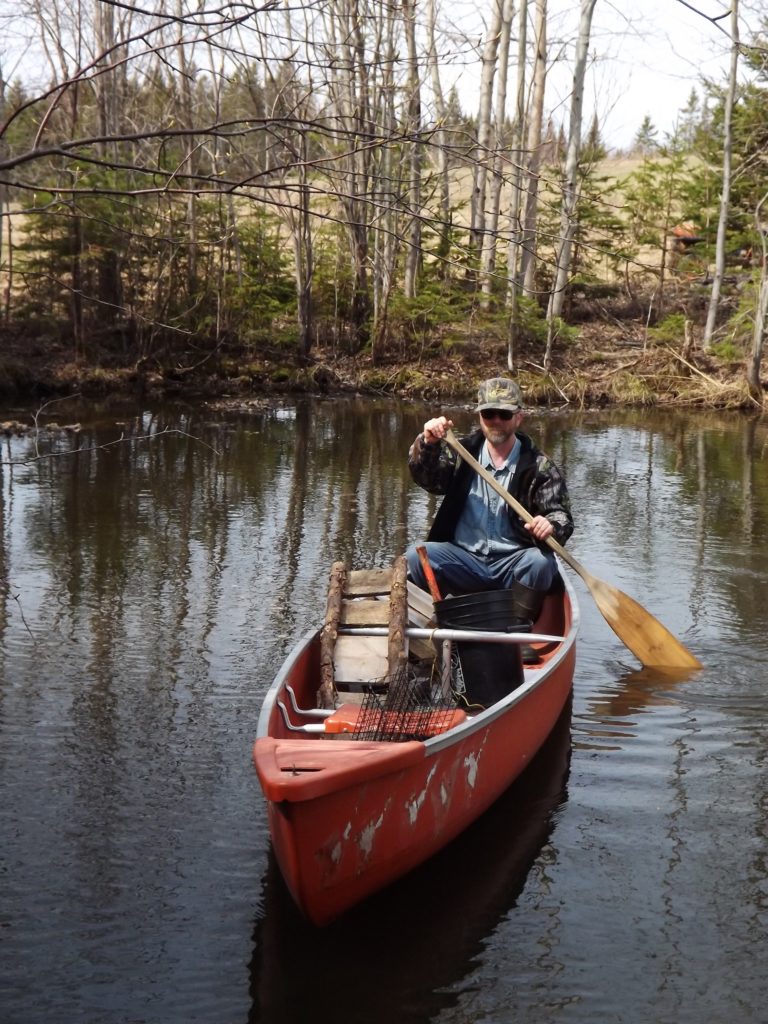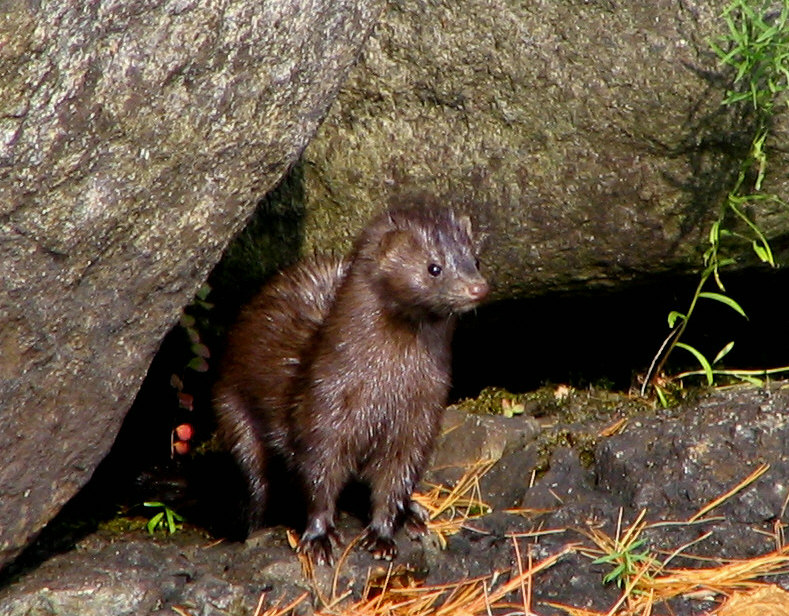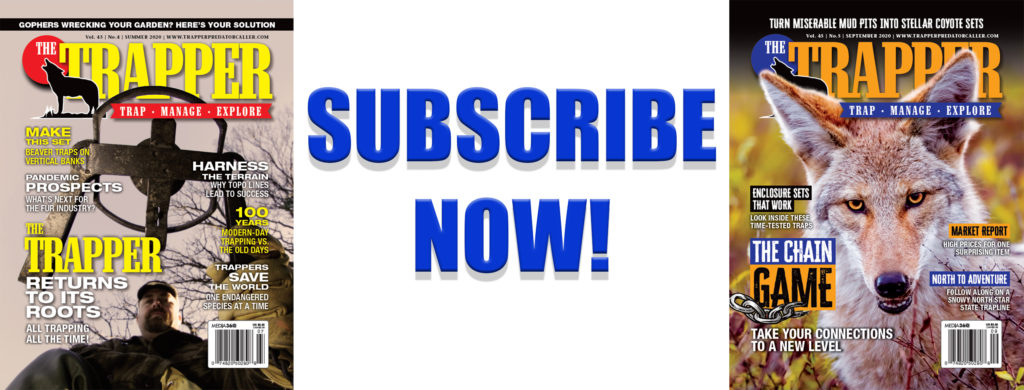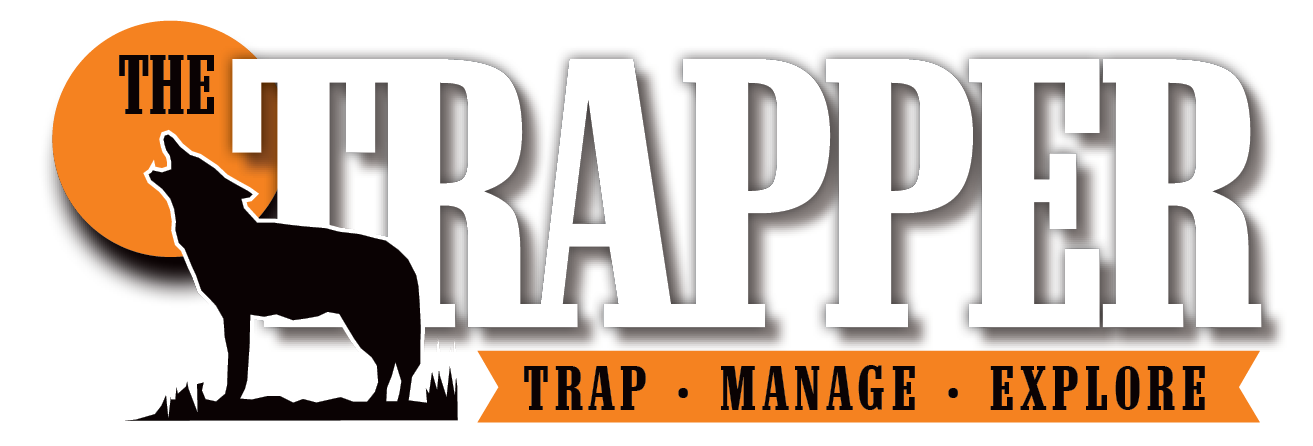These are the little things that the trapping pros do to set personal bests.
By Serge Lariviére
Large catches always fascinate trappers. Whether it is 500 mink, 2,000 raccoons, 1,000 foxes, 300 coyotes, 200 marten or 500 beavers, trappers that reach exceptionally large catches always fascinate us.
And let’s admit it — the first thing we seek to know is the how? Which set? Which bait? Which lure? Which trap size? Trap paint or logwood? What kind of snare lock? What kind of drowning system? What size cable? Wire or cable? Trigger on top or on the bottom? Longspring or coilspring? Heck, we even pay attention to the type of shovel they use, the boots they wear or the brand of truck they drive.
The truth of the matter is all this technical information is not why such large catches were made. Large catches were made because of very simple things that, albeit small, matter more than anything else. And regardless of whether it is a guy catching 100 lynx a year, 500 mink, 2,000 raccoons or 50 timber wolves, large number catches usually have these top 10 things in common.
ABUNDANCE
No other factor comes close in importance to this one. If the animals are not there, I do not care who you are, you will not catch them. If you took the best raccoon trapper you know and sent him to Alaska, his raccoon catch would plummet. If you took a 500-coyote-a-year guy from out West and sent him to northern Maine, he would struggle to reach 50.
We shy of talking about many of the most famous longliners’ methods, not because they were secrets, but because the actual catching methods were so simple it was scary. They felt it was better to shut up than to reveal how simple it was, because then people might start thinking about the where instead of the how. The where is by far the most important aspect. You want to double your catch? Go where the animals are twice as abundant. Without changing anything else, you will catch twice as many.
Now abundance might mean moving to a different area or simply being lucky enough to experience a natural boom in animal density in your area. Northern lynx trappers know well that in years of peak abundance, large catches are easy compared to when populations start going down. If you know that populations are on an upswing in your area, capitalize on it if you want to break your own record. And if you have the possibility of moving or trapping elsewhere, the first and most important step is to find where the highest densities are. Then go there.
AREA
Say you found a dream place — raccoons so thick it is scary. In fact, your state biologist tells you that local density is say 20 raccoons per square mile. But wait, you can only access one quarter section. The rest is off-limits. Hmm, great density, but even at high density, the area that you can cover is so small that you only can reach five raccoons. No good.
So, next in importance after abundance is area. Simply put, the larger the area you can cover, the more animals are exposed to your sets and the greater the odds are of a good catch. Many trappers question longliners about sets, baits and lures when the most important question is really, “How big of an area do you trap?” That is where longliners are king.
Longliners know that to catch a bunch of fur, they have to burn gasoline, move around and travel fast. Depending on check laws and planning skills, longliners might opt to rotate lines on a daily, weekly or monthly basis. Covering as much ground as possible allows you to harvest as many different animals as possible. Don’t make 100 sets for the same 10 animals. Longliners space out their locations so that they are not a mile down the road trying to catch the coyote they just caught on the neighboring farm.
GPS technology will easily reveal how close your sets are, and sometimes, it is very humbling. If two agricultural roads parallel each other and you drive both, you might actually be competing with your own sets less than a mile away.
Covering as much new ground as possible is key. In my previous example where there were 20 raccoons per square mile, if I had 10 square miles, that is 200 racoons. If I can set more than 100 square miles, now I can reach 2,000 racoons. With 200 square miles, I can access 4,000 raccoons. You get the point. Cover some ground.
ACCESS
Let’s say you have density and can cover a huge area, but access to locations is terrible. I will use beavers as a case study for this one. You find great beaver density, large areas of it, but each beaver lodge or colony is 400 yards from the main road. I can tell you large catches will be tough as the travel back and forth, especially with heavy traps and heavy animals, will slow you down.
You want to catch huge amounts of beavers? Access is key. If beavers can be caught at roadsides, life is great. Up North, this is the main reason large number beaver trappers trap out of a boat or wait until winter sets in so they can use a snowmobile to drive right up to the location. Walking long distances on a beaver line might be fun and great exercise, but it likely won’t result in much time in the skinning shed.
Roadside raccoons, mink in culverts, snowmobiles for marten and lynx, boatside beavers, anyone who makes huge catches of anything has got to have easy access to the locations. No one makes large catches with a packbasket on his back and a sandwich in his pocket. It’s romantic, yes, but not the way to make record catches.
COMPETITION
Next in importance is competition. Simply put, the only way to make huge catches is the absence of competition. If you find the best abundance over a large area and great access but competition is high, you might actually do better to move off elsewhere.
The animals you have available to catch are like a pie. Your piece will get smaller as others come in and get a piece also. Competition is tough, because finding good areas and getting set up properly takes time, and it is heartbreaking to abandon good locations and great places. It’s a lot of work to start again elsewhere. However, competition will hurt your catch and impair your ability to really shine.
Some say that competition will make you a better trapper. I agree. But competition will reduce your catch. What do you want most? To catch 1,000 raccoons as an average trapper or catch 400 and feel you are the king of your three competitors who only caught 200 raccoons each?
Getting the whole pie is always better than sharing it, and record catches most often come from low-competition areas.
TIME
Fifty raccoons a day over a 10-day period is 500 raccoons. That’s not a bad catch by any means. But 20 raccoons a day over a 50-day period means 1,000 raccoons. Time is also one of the top variables for huge catches. The longer you trap, the more animals you will catch.
Record catches often are made under very special conditions, but they almost always occur when the trapper kept going for a long period of time, often long after everyone else has quit.
The same thing goes with part-time trappers. The guy who has four weeks of vacation to trap will catch more fur than the guy who has only two weeks with all else being equal. So, if you want to break records, you better find a way to find some time.
Longliners will tell you that if trapping for 10, 20 or even 30 days is fun, things change when you get up to Day 40 or longer. The physical stamina and mental attitude needed to keep going day after day is an asset of longliners, but first and foremost, each additional day on the trapline means more fur. So, after you find the animals, finding the time to harvest them should be high on the priority list.
WEATHER
Weather and time are closely related. Open-water trappers know all too well how early frost or early snowfall might ruin even the best-laid plans. Late freeze-up is a nightmare for snowmobile trappers, and big snowfalls or big floods ruin many trapping campaigns.
The truth is the weather influences our catch by influencing animal movements or by affecting the time or effectiveness of our sets. You can have four weeks of vacation and only be able to set and check for two weeks because of weather.
You can’t do anything about weather other than plan for the worst and hope for the best. If you have dream conditions for twice as long as a normal year, chances are that is when your catch will be twice what it normally is.
LOGISTICS
Logistics encompasses many different aspects of trapping, but overall, when logistics are well organized, huge catches are easier. Included in logistics is catch handling and transport, fur handling facility, access to freezers, locations of gas stations, gates to open and close, people to talk to, cell-phone coverage in case of break down, backup vehicles in case of mechanical problems, arranging for peaceful sleeping places and much more. Some of these might sound bizarre from those who trap from their homes, but on faraway trapping camps, logistics can be real barriers to productivity.
How can you deal with 50 raccoons a day if you don’t have a buyer nearby or a place inside to skin them? If you catch frozen coyotes or wolves by snowmobile, you better find a good sled to pull behind. Ever wondered how to deal with 200 beaver carcasses on a spring trapline? That is three tons of meat to dispose of. You have to have a good plan before your start.
Luckily, logistics are in the hands of the trapper, so there is something we can do about it. But when logistics get complicated, they can impair your ability to harvest additional animals and reach record-high catches.
DISTRACTIONS/INCIDENTALS
Incidental furbearers — a mink in a ’coon set, a ’rat in a mink set, a ’coon in a fox set, etc. — all add to the joys of the trapline. Most of us find great pleasure in these occasional surprises. However, for large catches, incidentals should be kept as rare as possible.
You cannot catch a mink if there is a muskrat in the trap, and that fox set is useless if a skunk gets there first. Record catches are often made in areas of low incidentals or by using methods that are very species-specific. Sure, varied catches look nice on a barn, but for high numbers, trappers have to focus on one species.
Everything is streamlined for one species — equipment, skinning, handling, baits, lures, locations. Every time you switch to another species, you lessen your chances of advancing your catch on your target species. Trappers who target everything on their line make nice catches, and I think this is the most fun trapping, but if you want to exceed 1,000 beavers this fall, you better not stop to set for mink, muskrats and otters. You will already have to deal with the ones that plug your beaver sets. If you stop for them on purpose, you will lower your beaver catch on purpose. A trapper has to make that decision and assume the consequences. It’s tough to pass a sure-fire otter toilet, but traps set there will not catch beavers, so what do you want most?
Distractions fit in the same category. If you stop along the way to shoot a duck or two, shoot that grouse on the roadside or grab the muzzleloader because you saw a buck walk in that brushed-in fenceline, you are taking time away from your trapping. A stop at the nearby restaurant to chat with the locals, a long pause to make a phone call for your business or a stop to help a stranded motorist are all good things that trappers have to do from time to time. Just be aware that these time eaters reduce your productivity.
The more you can do before the season or after hours, the better. Gas up at night, eat on the run, do your preventive maintenance and do what you can before the season starts so your distractions are as few as possible.
UNIFORMITY
Longliners use a system, not a set. They always do things the same way, trying to streamline everything to its most simple and efficient form. They don’t do anything complicated. They don’t spend time looking things over and thinking. They walk in, set, move off 10 feet, set again, walk back and drive on. And then repeat this process until the day is over, repeat the daily process until the week is over and repeat the weekly process until the month or season is over.
Longliners can seem boring in the sense that after you have seen one of their sets, most of the rest are very likely to be done the same way. There is no randomization of sets, baits or lures. It’s almost as though they are robots — grab trap, grab bait, grab lure, make set, walk back, drive to next location. Wake-up times and bed times do not vary. Routines are necessary for success. If you improvise your schedule, you lose.
Uniformity also will be noticed in equipment. You won’t find longliners with five types of traps that serve the same purpose. They have one they like best, and they have 500 of the same exact model, modified the same exact way. There is no deciding on the spot. Sure, locations will sometimes dictate differences, but the mechanics of sets will remain, whether it is dirtholes, pocket sets, bodygripping boxes, cubbies, mud pies, under-ice snares or another set.
ACCEPTABILITY
The last one might sound weird, but it does impact the ability to score big. Acceptability is a general term used to describe other people’s reaction to your decision to go big. Whether it’s your close family, loved ones, kids, parents, neighbors, landowners or even the other users of the land where you trap, if the acceptance is not there, it will slow you down and reduce your ability to shine.
Landowners are key in this, but even the general tolerance of the population to trapping is important. Imagine if you had to trap in a community with several anti-trappers. Everything you do would have to be hidden and disguised. Every encounter with another human being would make you nervous.
Now imagine trapping coyotes for a group of sheep farmers who would go out of their way to help you. They would even understand if you made some mistakes or caused some problems — gates left open, tire ruts after three days of rain, daily stink from the carcass pile, dogs barking as you drive by the ranch house, etc. When you trap with a peaceful mind, you can do better than when you feel you are under constant surveillance.
Family acceptance is no small thing either. You cannot succeed without the love and support of your family and loved ones. A little help is great if you can get it. It’s outstanding if you can get a lot of it. But at least knowing that people support your desire to be a longliner will go to great lengths in helping you keep going, especially the day you get sprayed by a skunk just before sinking your truck to the axles just off the beautiful mowed-lawn farm lane next to the ranch house with the dog barking at 5 a.m. on a Sunday morning.






